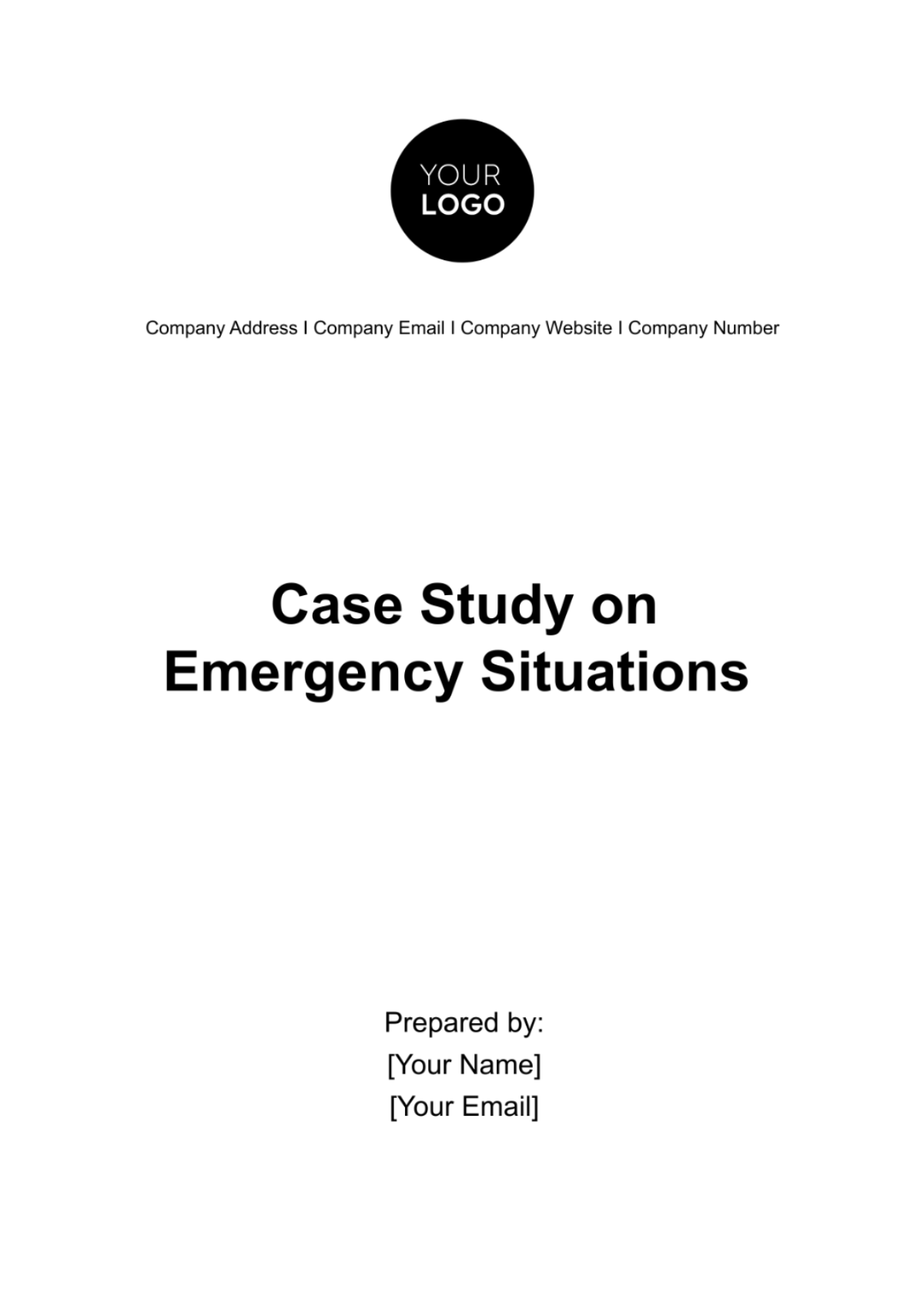Free Case Study on Emergency Situations

I. Executive Summary
This case study provides an in-depth analysis of a significant power outage incident at [Your Company Name]'s main manufacturing facility, a critical hub for the company’s operations. The power outage, caused by a severe storm that impacted the local power grid, resulted in a complete halt of production activities for 48 hours, posing substantial challenges to our operational continuity and client commitments.
The objective of this study is to meticulously examine the context of the power outage, the immediate actions taken by the emergency response team, and the overall effectiveness of these actions in managing the crisis. By doing so, we aim to extract valuable insights and identify areas for improvement in our emergency response protocols and preparedness strategies.
Key findings from this analysis reveal that while the activation of backup generators was successful in maintaining critical systems, the limited capacity of these generators meant that a significant portion of operations remained offline, leading to production delays and financial implications. The study also highlights the effectiveness of our communication strategy during the incident, which helped in managing stakeholder expectations and mitigating potential reputational damage.
Significant conclusions drawn from this case study include the need for enhancing our facility's power backup capacity, possibly through investments in higher-capacity generators or alternative energy sources. Furthermore, the incident underscores the importance of regular emergency response drills and staff training, ensuring that all employees are better prepared for similar situations in the future.
II. Background and Context
[Your Company Name] is a prominent player in the manufacturing sector, specializing in the production of [specific products or services]. Our main facility, a cornerstone of our production capacity, is situated in an industrial zone known for its technological advancements and high-density manufacturing operations. This location is strategically chosen for its proximity to key supply chains and logistics networks, essential for efficient production and distribution.
The facility itself is equipped with state-of-the-art machinery and cutting-edge technology, making it a critical asset in our operational framework. It is designed to support high-volume production with a focus on [specific aspects of production, e.g., precision, speed, automation]. The workforce here comprises skilled technicians, engineers, and operational staff, all integral to our day-to-day operations.
However, the region where the facility is located has a history of power instability. Despite being a hub of industrial activity, it suffers from an outdated power grid, struggling to keep up with the high energy demands of the area. Prior to the major power outage incident, the facility had encountered several minor power disruptions, which had caused brief periods of downtime and raised concerns about potential vulnerabilities in our operational preparedness. These smaller incidents, while manageable, were indicative of a larger underlying issue with power supply reliability in the region.
Furthermore, the local climate contributes to this challenge. The area is prone to severe weather conditions, particularly storms and heavy rainfall, which have previously resulted in power issues. Recognizing these risks, [Your Company Name] had implemented some measures to mitigate potential disruptions, but the unprecedented scale of the power outage incident highlighted the need for a more robust and comprehensive approach to managing such emergencies.
III. Description of the Emergency Situation
On [Date], [Your Company Name] faced a critical emergency when a severe storm, unprecedented in its intensity, swept through the region, causing extensive damage to the local power grid. This resulted in a major power outage at our main manufacturing facility, lasting for approximately 48 hours. The storm, characterized by powerful winds and heavy rainfall, not only disrupted the power supply but also posed logistical challenges due to flooded roads and impaired communication lines.
A. Specific Challenges
The power outage led to an abrupt halt in all production processes. Our facility, reliant on a consistent power supply for operating advanced machinery and production lines, was rendered completely inactive.
The outage impacted our IT infrastructure, disrupting data systems and internal communication networks. This posed a significant challenge in coordinating an effective response and maintaining operational continuity.
With the emergency lighting and security systems compromised, there were heightened concerns for the safety and security of the facility, especially overnight.
B. Immediate Impact on Operations
The cessation of production activities led to immediate delays in fulfilling existing customer orders, with the potential for cascading delays in our supply chain.
The production halt had significant financial implications, including potential revenue loss and the costs associated with emergency response measures and recovery efforts.
The outage affected employee productivity, with staff unable to perform their regular duties. Additionally, there was a noticeable impact on employee morale, with concerns over potential prolonged disruptions and job security.
IV. Emergency Response Actions
As soon as the power outage occurred, [Your Company Name]'s emergency response team sprang into action, guided by a well-defined emergency response plan tailored for such critical situations.
A. Activation of Backup Power Systems
The first response to the power outage was the immediate activation of backup generators by the facility’s maintenance team. This quick action ensured that critical systems, including essential machinery, safety alarms, and IT servers, remained operational.
The team, led by the Facility Manager, worked swiftly to assess the backup generators' capacity, ensuring they could sustain critical operations for the duration of the outage.
B. Communication Protocols
The internal communication team, using emergency communication channels, quickly disseminated information to all employees, explaining the situation and providing instructions for immediate actions.
The Public Relations Manager, in collaboration with the client services team, sent out notifications to stakeholders and clients. These communications detailed the nature of the incident, the expected impact on operations, and an estimated timeline for resolution. Regular updates were scheduled to keep all parties informed.
C. Conservation and Adaptation Measures
To conserve energy, the team decided to shut down all non-essential systems. This action was critical in extending the backup power supply's duration and maintaining essential operations.
Recognizing the need to maintain some level of productivity, the Operations Manager implemented a temporary shift rotation plan. This strategy involved redistributing available manpower to critical tasks, ensuring partial continuity of production processes despite reduced capacity.
D. Safety and Security Measures
With the regular security systems compromised, additional security measures were put in place. This included manual monitoring of critical areas and the implementation of temporary safety protocols.
The Safety Officer conducted quick briefings to all personnel on safety measures during the outage, ensuring that everyone understood how to operate safely under the altered conditions.
V. Outcome and Impact Analysis
The backup generators successfully powered critical systems, preventing data loss and equipment damage. However, the production capacity was reduced by 40% during the outage. Client communications were well-received, mitigating potential reputational damage. Financially, the incident led to a temporary setback due to production delays.
A. Effectiveness of Response in Mitigating Damage
Systems and Data Protection: The swift activation of backup generators played a crucial role in safeguarding critical systems. This action was pivotal in preventing data loss and equipment damage, which could have had far-reaching consequences on [Your Company Name]'s operational capabilities. |
Production Impact: Despite a reduction in production capacity by 40%, the measures to prioritize and maintain essential operations ensured that critical processes continued. This selective continuity helped in minimizing the potential scale of disruption. |
B. Protection of Employees and Assets
Employee Safety and Morale: The prompt communication and clear instructions regarding safety procedures ensured that employees felt informed and secure during the outage. The temporary operational adjustments, while challenging, also helped in maintaining a sense of normalcy and purpose among the workforce. |
Asset Preservation: Through effective power management and the shutting down of non-critical systems, the physical assets of the company were preserved from potential risks associated with the power outage, such as electrical surges or operational stress. |
C. Maintaining or Restoring Operations
Short-Term Operational Resilience: In the short term, the ability to continue key operations, even at a reduced capacity, demonstrated [Your Company Name]'s resilience. The measures taken ensured a baseline of productivity was sustained, preventing a complete operational standstill. |
Client Relations and Reputation: The proactive and transparent communication with clients helped in managing expectations and preserving trust. This approach was instrumental in mitigating potential reputational damage and maintaining client relationships despite the operational challenges. |
D. Short-Term and Long-Term Impacts
Financial Implications: In the short term, the incident resulted in a temporary financial setback, primarily due to the reduction in production output and the associated delays in order fulfillment. There were also costs involved in the emergency response and subsequent recovery efforts. |
Long-Term Considerations: In the long run, the incident has highlighted areas for improvement in emergency preparedness, particularly in enhancing power backup capabilities and refining business continuity strategies. The lessons learned are likely to inform future investments in infrastructure and training, potentially leading to increased operational resilience and a stronger market position. |
Operational Improvements: The experience gained from managing this emergency provides a valuable blueprint for handling similar situations in the future. The company is now better positioned to respond to power-related disruptions and other emergencies with greater effectiveness and confidence. |
VI. Lessons Learned and Recommendations
The incident underscored the need for a more robust power backup system. It is recommended that [Your Company Name] invests in higher-capacity generators and explores renewable energy options. Enhanced training for employees on emergency protocols and regular drills are also advised to ensure better preparedness for similar future incidents.
A. Critical Evaluation of the Emergency Situation and Response
The power outage incident at [Your Company Name] revealed both strengths and vulnerabilities in our emergency response system. The effectiveness of the immediate activation of backup generators and the established communication channels was a testament to our preparedness level. However, the incident also exposed the limitations of our current power backup system and the need for more comprehensive employee training in emergency protocols.
B. Key Lessons Learned
The reliance on a limited backup power system highlighted the need for a more comprehensive approach to ensure operational continuity.
The positive reception of our communication efforts with clients and employees underscored the importance of transparency and proactive communication in crisis management.
The incident revealed areas for improvement in staff familiarity with emergency procedures, especially in adapting to changing roles and responsibilities during an emergency.
C. Recommendations for Improvements
Upgrade Power Backup and Energy Solutions: Invest in higher-capacity generators to provide sufficient backup power for all critical systems. Additionally, explore renewable energy options, such as solar panels or wind turbines, to create a more sustainable and reliable energy backup solution.
Implement Comprehensive Emergency Training Programs: Develop and implement a more robust training program for employees that covers various emergency scenarios. This program should include regular drills, practical exercises, and training sessions to ensure that all staff are well-prepared and familiar with the emergency protocols.
Enhance Resource Management Strategies: Establish a clear resource management strategy for emergencies, which includes pre-identifying and allocating resources for various crisis scenarios. This strategy should also involve establishing partnerships with local suppliers and emergency services for quick resource mobilization.
Review and Update Emergency Response Plan Regularly: Conduct regular reviews of the emergency response plan to incorporate lessons learned from recent incidents. These reviews should involve input from all levels of the organization and be updated to reflect changes in the business environment or operational structure.
VII. Conclusion
The power outage incident at [Your Company Name]'s main manufacturing facility has been a defining moment in our approach to emergency management. This case study has meticulously documented the incident's challenges and our response, providing us with invaluable insights that extend far beyond the immediate crisis management.
A. Summary of Main Insights
The incident underscored the importance of having resilient systems and protocols in place. Our response demonstrated the effectiveness of some existing strategies, such as immediate crisis communication and rapid activation of backup systems.
The power outage highlighted critical areas requiring enhancement, particularly in our energy backup capabilities and the breadth of emergency training provided to our employees.
A key insight from this incident is the need for proactive, rather than reactive, planning. Anticipating potential emergencies and preparing accordingly can significantly mitigate the impact of such events.
B. Continual Learning and Adaptation
[Your Company Name] is dedicated to learning from this experience. We understand that emergency management is a dynamic field, requiring constant adaptation and improvement.
In line with the recommendations from this case study, we plan to invest in more robust power backup solutions and renewable energy sources. Additionally, we are committed to enhancing our emergency training programs, ensuring all employees are thoroughly prepared for various crisis scenarios.
Going forward, we will establish a regular schedule for reviewing and updating our emergency response plans. This will involve not just responding to incidents that have occurred but also anticipating future challenges and evolving industry best practices.
C. Enhancing Emergency Preparedness and Response
We recognize that effective emergency management encompasses more than immediate response actions. It includes building a culture of preparedness, resilience, and adaptability across the entire organization.
We will continue to engage with our employees, clients, and local emergency services, taking their feedback into account to refine our strategies and practices.
This case study is a part of our ongoing journey towards excellence in emergency management. By implementing the lessons learned and continually seeking improvement, [Your Company Name] aims to not only strengthen its response to power-related disruptions but also enhance its overall preparedness for a wide range of potential emergencies.
Prepared by:
[Your Name]
[Your Job title]
[Your Company Name]
[Your Email]
[Your Company Number]
Health & Safety Templates @ Template.net
- 100% Customizable, free editor
- Access 1 Million+ Templates, photo’s & graphics
- Download or share as a template
- Click and replace photos, graphics, text, backgrounds
- Resize, crop, AI write & more
- Access advanced editor
Explore emergency situations with ease using Template.net's Case Study on Emergency Situations Template. This editable and customizable tool offers insightful case studies for analysis. Tailor content effortlessly with our Ai Editor Tool, ensuring it meets your specific needs. Trust Template.net for comprehensive solutions in emergency preparedness studies.





























